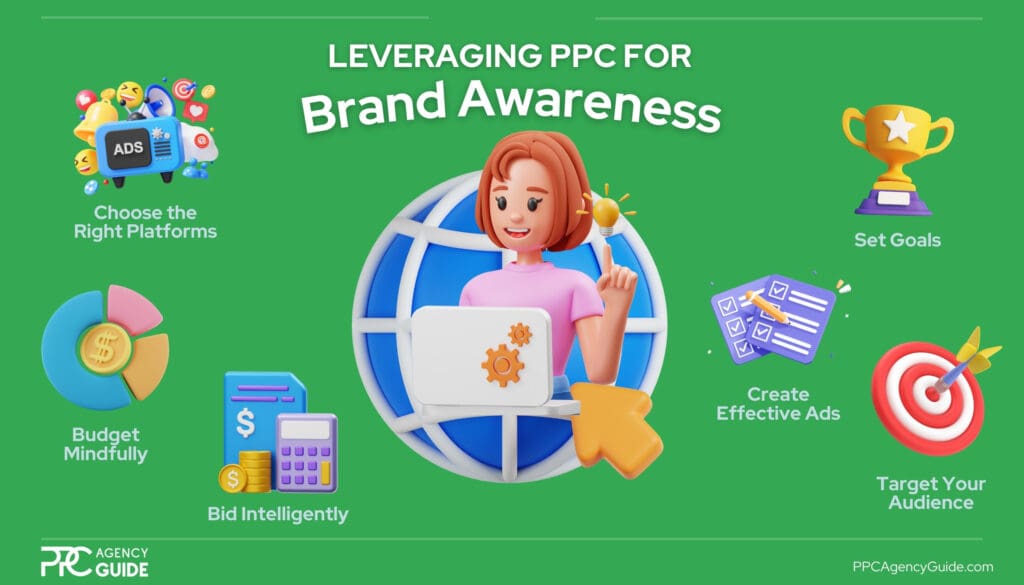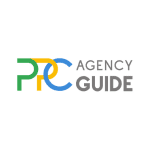
Imagine your brand being the first thing potential customers see when they search online, consistently appearing in front of the right audience and making a lasting impression. That’s the power of pay-per-click (PPC) advertising for brand awareness. Whether you’re a small business looking to build a local presence or an established company that wants to reinforce your market dominance, this guide will unlock the secrets to using PPC to elevate your brand and dominate your market.
Introduction to PPC Advertising
Before we get into strategies, let’s start with some basic information about PPC.
Definition and Basics of PPC Advertising
PPC advertising is an online marketing strategy where advertisers pay a fee each time one of their ads is clicked. Essentially, it’s a way of buying visits to your site rather than attempting to “earn” those visits organically. PPC is commonly associated with search engine advertising, where businesses bid for ad placement in a search engine’s sponsored links when someone searches for a keyword related to their business offering.
For instance, if you bid on the keyword “tax preparation services,” your ad might appear at the top of the Google search results page when someone searches for that term. Each time your ad is clicked, sending a visitor to your website, you pay the search engine a small fee.
How PPC Works
PPC advertising is built on a complex system of algorithms and auction models that determine the placement and cost of ads. Here’s a simplified breakdown of how it works.
- Keyword Research and Selection: Advertisers choose relevant keywords that potential customers might use when searching for their products or services. Tools like Google Keyword Planner can help identify these keywords.
- Ad Creation: Compelling ads are created to attract clicks. These ads typically include a headline, a brief description, and a URL to the landing page.
- Bidding: Advertisers set a maximum bid, which is the most they are willing to pay for a click on their ad. This bidding process is competitive, and higher bids can increase the likelihood of ad placement.
- Ad Auction: When a user enters a search query that matches the advertiser’s keywords, an ad auction takes place. The auction considers the bid amount and the ad’s Quality Score (a measure of the ad’s relevance and quality) to determine the ad’s placement.
- Ad Placement: The ads that win the auction are displayed on the search engine results page (SERP) or on relevant websites in the case of display ads.
- Payment: Advertisers only pay when their ad is clicked, hence the name “pay-per-click.”
Benefits of PPC for Brand Awareness
PPC advertising is effective for many reasons.
- Immediate Results: Unlike SEO, which can take months to show results, PPC ads can generate traffic as soon as the campaign is live. This is crucial for businesses that want to gain quick visibility.
- Targeted Reach: PPC allows for precise targeting based on keywords, location, demographics, interests, and even the time of day. This ensures that ads are shown to the most relevant audience, increasing the chances of conversions.
- Cost Control: Advertisers have full control over their budgets and can set daily or monthly limits to ensure they don’t overspend. PPC platforms also provide detailed analytics to measure ROI and optimize spending.
- Measurable Performance: Every aspect of a PPC campaign can be tracked and analyzed, from impressions and clicks to conversions and sales. This data-driven approach helps refine strategies and improve campaign performance over time.
- Enhanced Brand Visibility: Even if users don’t click on the ads, appearing at the top of search results or on popular websites can significantly boost brand recognition and credibility.
Setting Up a PPC Campaign
Setting up a PPC campaign for brand awareness is similar to running a traditional campaign but with a few nuances.

Choosing the Right Platforms
Selecting the right platform for your PPC campaign is crucial for effectively reaching your target audience. Below are some of the most popular PPC platforms.
- Google Ads: The largest and most widely used PPC platform, Google Ads offers search ads, display ads, shopping ads, and video ads on YouTube. It’s ideal for businesses that want to target users actively searching for specific products or services.
- Facebook Ads: With its vast user base and detailed targeting options, Facebook Ads allows businesses to create highly specific audience segments based on demographics, interests, and behaviors. It also offers Instagram integration for visual ad campaigns.
- Microsoft Advertising: While smaller than Google, Microsoft Advertising can be valuable for reaching an older, more affluent audience. It offers similar features to Google Ads but often at a lower cost per click.
- LinkedIn Ads: Perfect for B2B marketing, LinkedIn Ads allows targeting based on job title, industry, company size, and other professional criteria. It’s ideal for campaigns aimed at professionals and businesses.
- X Ads: Formerly known as Twitter, X offers promoted tweets, accounts, and trends, making it a good choice for real-time engagement and reaching a younger, more tech-savvy audience.
- Amazon Advertising: For e-commerce businesses, Amazon Advertising can be highly effective. It allows shoppers to be targeted directly on the Amazon platform, where they are already in a buying mindset.
Setting Goals and Objectives for Brand Awareness
Determining clear goals and objectives is essential before launching a PPC campaign. Below are a few examples related to branding.
- Increase Reach and Impressions: Aim to get your ads in front of as many people as possible. Metrics like impressions and reach are key indicators.
- Enhance Brand Recall and Recognition: Create memorable and consistent ads with your brand identity, helping potential customers remember your brand.
- Drive Traffic to Your Website: Focus on attracting new visitors to your website, where they can learn more about your brand and offerings.
- Engage with Your Audience: Depending on the platform and ad format, encourage interactions through likes, shares, comments, or video views.
Setting SMART (specific, measurable, achievable, relevant, time-bound) goals will help you measure the success of your campaign effectively.
Budgeting and Bidding Strategies for Brand Awareness Campaigns
Effectively managing your budget and bidding strategies is crucial to maximizing the impact of your PPC campaigns. Here are some key considerations to ensure your brand awareness efforts are both efficient and effective.
Budgeting
- Determine Your Overall Budget: Decide how much you are willing to spend on your PPC campaign. This should be a balance between your marketing budget and the potential return on investment.
- Allocate Your Budget Wisely: Distribute your budget across different platforms and ad formats based on where your target audience is most active and where you see the best results.
- Monitor and Adjust: Keep an eye on your campaign’s performance and be prepared to reallocate budget to higher-performing ads or platforms.
Bidding Strategies
- Manual CPC Bidding: Allows you to set the maximum cost per click for your ads. This gives you control over your budget but requires regular monitoring and adjustments.
- Automated Bidding: Platforms like Google Ads offer automated bidding strategies that optimize bids to meet your goals. For brand awareness, consider strategies like Target Impression Share, which aims to show your ads in a certain percentage of eligible searches.
- Cost-Per-Thousand Impressions (CPM): This strategy is often used for brand awareness campaigns, where you pay for every 1,000 impressions your ad receives. It’s useful when the primary goal is to get your ad seen by as many people as possible.
- Enhanced CPC (ECPC): A semi-automated strategy where you set your base bid, and the platform adjusts it to maximize conversions while staying within your budget.
- Target Outranking Share: Useful in competitive markets, this strategy lets you bid to outrank specific competitors’ ads in search results.
Creating Effective PPC Ads
Creating compelling PPC ads is essential to capture your audience’s attention and drive engagement. Let’s explore the key elements that contribute to the success of your PPC advertisements.
Crafting Compelling Ad Copy and Visuals
The success of your PPC campaign heavily relies on the quality of your ad copy and visuals. These elements must be designed to attract and engage your target audience effectively.
Ad Copy
Creating compelling ad copy is crucial for capturing attention and driving clicks. Here are some tips.
- Clear and Concise Messaging: Ads should be easy to read and understand quickly. Focus on delivering your key message in a concise manner.
- Strong Headlines: Your headline is the first thing people see. Make it attention-grabbing and relevant to the user’s search query or interests. Use numbers, questions, or strong action words to make it stand out.
- Value Proposition: Clearly communicate the unique benefits of your product or service. What makes it better or different from competitors?
- Call to Action (CTA): Encourage users to take the next step with a clear and compelling CTA. Phrases like “Shop Now,” “Learn More,” “Get a Quote,” or “Sign Up Today” can drive action.
- Relevance: Ensure your ad copy matches the keywords you are targeting and aligns with the user’s intent. This improves your Quality Score and ad performance.
Visuals
For platforms like Facebook and Instagram, visuals play a significant role.
- High-Quality Images and Videos: Use clear, high-resolution images and videos that are relevant to your ad’s message. Poor-quality visuals can negatively impact the perception of your brand.
- Consistent Branding: Maintain a consistent look and feel with your brand colors, fonts, and logos. This helps in building brand recognition.
- Eye-Catching Design: Use bold colors, interesting compositions, and compelling visuals to draw attention. Ensure that the design is not cluttered and that the main message is easy to see.
- Relevant Imagery: Use visuals that are directly related to your product or service. Avoid generic stock photos if possible, as they can appear inauthentic.
Using Keywords Effectively for Brand Reach
Keywords are the foundation of any PPC campaign, especially for search ads. Here’s how to use them effectively.
- Keyword Research: Use tools like Google Keyword Planner, Semrush, or Ahrefs to identify relevant keywords for your business. Focus on keywords that have a good balance of search volume and competition.
- Match Types: Utilize different keyword match types (broad match, phrase match, exact match) to control how closely the search queries must match your keywords for your ads to appear. For brand awareness, broad match can help you reach a wider audience.
- Negative Keywords: Identify and exclude irrelevant keywords that you don’t want your ads to show for. This prevents wasted ad spend on non-relevant traffic.
- Long-Tail Keywords: Targeting long-tail keywords can help you reach a more specific audience with less competition. These are longer, more specific keyword phrases that users are likely to use when they’re closer to making a purchase.
- Ad Groups: Organize your keywords into tightly themed ad groups. This ensures that your ads are highly relevant to the search queries, improving your Quality Score and ad performance.
The Importance of Landing Pages and User Experience
The landing page is where users land after clicking your ad. It plays a crucial role in converting clicks into customers. As you develop yours, ensure the following best practices are addressed.
- Relevance: Ensure that the landing page content is directly related to the ad copy and keywords. If users don’t find what they were expecting, they will likely leave the page quickly.
- Clear CTA: Just like in your ad copy, your landing page should have a clear and compelling CTA. Make it easy for users to take the desired action, whether it’s making a purchase, signing up, or contacting you.
- Design and Layout: The landing page should be visually appealing and easy to navigate. Use a clean, uncluttered design with plenty of white space. Important elements should be above the fold.
- Fast Loading Times: A slow-loading page can drive visitors away. Optimize images, reduce unnecessary scripts, and use fast hosting to ensure quick load times.
- Mobile Optimization: Ensure that your landing page is fully optimized for mobile devices. With a growing number of users browsing on their phones, a mobile-friendly design is essential.
- Trust Signals: Include trust signals such as customer testimonials, reviews, security badges, and guarantees to build credibility and encourage conversions.
Targeting Strategies
To maximize the effectiveness of your PPC campaigns, it’s crucial to implement precise targeting strategies. Let’s explore a few approaches you can use to reach your ideal audience.
Audience Segmentation and Targeting Options
Audience segmentation involves dividing your target market into distinct groups based on specific criteria to deliver more personalized and relevant ads. Here’s how to do it effectively.
- Demographic Segmentation: Segmenting your audience based on age, gender, income, education, and other demographic factors helps tailor your ads to specific groups.
- Geographic Segmentation: Target users based on their location, from country and city levels down to zip codes and neighborhoods. This is especially useful for local businesses or campaigns focusing on regional markets.
- Behavioral Segmentation: This involves targeting users based on their behavior online, such as past purchases, browsing habits, and engagement with previous ads.
- Psychographic Segmentation: Segmenting based on lifestyle, values, interests, and personality traits helps create more engaging and relatable ads.
- Contextual Targeting: Display ads on websites that are relevant to your product or service, ensuring that your ads are seen in the right context.
Utilizing Demographic, Geographic, and Interest-Based Targeting
By leveraging demographic, geographic, and interest-based targeting, you can ensure your ads reach the most relevant audience. These targeting methods allow you to tailor your campaigns to specific groups, maximizing engagement and effectiveness.
Demographic Targeting
- Age and Gender: Tailor your ads to specific age groups or genders. For instance, a beauty product might target women aged 18-34.
- Income Level: Luxury brands might target higher income brackets, while budget-friendly products target lower income segments.
- Education Level: Educational courses or high-tech products might target users with higher educational qualifications.
Geographic Targeting
- Location-Specific Campaigns: Create ads that appeal to local audiences, highlighting local events, weather, or regional preferences.
- Radius Targeting: For businesses with physical locations, target a radius around your store to attract local customers.
Interest-Based Targeting
- Hobbies and Interests: Platforms like Facebook allow you to target users based on their interests, such as sports, travel, or cooking.
- Online Behavior: Track users’ online behavior, such as websites they visit and content they engage with, to target ads more precisely.
Remarketing Strategies to Reinforce Brand Awareness
Remarketing (or retargeting) is a powerful strategy to reinforce brand awareness by targeting users who have previously interacted with your website or ads. Here are some effective remarketing strategies.
- Site Visitors Remarketing: Target users who have visited your website but did not convert. Show them ads reminding them of your products or offering special promotions to encourage them to return.
- Cart Abandoners Remarketing: For e-commerce sites, target users who added items to their cart but didn’t complete the purchase. Display ads featuring the products they left behind, possibly with a discount.
- Customer List Remarketing: Upload a list of your customers’ email addresses to platforms like Facebook or Google Ads. Target these users with ads about new products, special offers, or loyalty programs.
- Engagement Remarketing: Target users who have engaged with your brand on social media or watched your videos. Show them more content to deepen their connection with your brand.
- Dynamic Remarketing: Show personalized ads based on the specific products or services users viewed on your website. This is particularly effective for e-commerce businesses.
- Video Remarketing: Target users who have watched your videos on YouTube or other platforms with follow-up ads, encouraging them to visit your site or watch more content.
Measuring Success
Accurately measuring the success of your PPC campaigns is essential for optimizing performance and achieving your branding goals. Here’s how to track the key metrics that matter most.
Key Metrics to Track
To measure the success of your PPC campaigns, it’s essential to track various key metrics that provide insights into your campaign’s performance.
- Impressions: The number of times your ad is displayed. This metric helps gauge how many people are seeing your ad.
- Reach: The total number of unique users who see your ad. Reach is crucial for understanding the breadth of your campaign’s exposure.
- Click-Through Rate (CTR): The percentage of impressions that result in clicks. CTR is calculated as (Clicks / Impressions) x 100. A higher CTR indicates that your ad is compelling and relevant to users.
- Cost Per Click (CPC): The average amount you pay for each click on your ad. CPC helps manage your budget and assess the efficiency of your ad spend.
- Conversion Rate: The percentage of clicks that result in a desired action, such as a purchase or sign-up. It’s calculated as (Conversions / Clicks) x 100. This metric measures the effectiveness of your landing page and overall campaign.
- Cost Per Conversion: The average cost to acquire a conversion. It’s calculated as (Total Spend / Conversions). This metric helps evaluate the return on investment (ROI).
- Quality Score: A metric used by Google Ads to measure the relevance and quality of your keywords and ads. Higher Quality Scores can lead to lower CPCs and better ad placements.
- Return on Ad Spend (ROAS): The revenue generated from your ad campaign divided by the cost of the campaign. It’s calculated as (Revenue / Ad Spend). ROAS helps determine the profitability of your campaign.
- Engagement Metrics: For platforms like Facebook, engagement metrics include likes, shares, comments, and video views. These metrics help assess how well your content resonates with the audience.
Tools for Measuring PPC Campaign Performance
Several tools can help you track and analyze your PPC campaign performance. We’ll outline a few below.
- Google Analytics: Integrates with Google Ads to provide detailed insights into how users interact with your website after clicking your ads. You can use Google Analytics to track conversions, set up goals, and analyze user behavior.
- Google Ads Dashboard: Provides comprehensive data on your ad campaigns, including impressions, clicks, CTR, CPC, and conversion metrics. The dashboard also offers insights into Quality Score and keyword performance.
- Facebook Ads Manager: Offers detailed analytics for Facebook and Instagram ad campaigns, including reach, engagement, CTR, and conversion data.
- Microsoft Advertising: Similar to Google Ads, it provides detailed performance metrics for campaigns run on Bing and Yahoo.
- Semrush: As a comprehensive digital marketing tool, Semrush includes PPC campaign tracking, competitor analysis, and keyword research.
- AdEspresso: A tool for creating, managing, and analyzing Facebook and Instagram ads. Additionally, AdEspresso provides A/B testing and detailed performance metrics.
- HubSpot: Offers integrated marketing tools, including PPC tracking, to measure the performance of your campaigns and their impact on overall marketing efforts.
How to Analyze and Optimize Campaigns for Better Results
Analyzing and optimizing your PPC campaigns is an ongoing process. Here’s how to do it effectively.
- Regular Monitoring: Keep a close eye on your key metrics and performance indicators. Regularly check your campaign dashboards to identify any significant changes or trends.
- A/B Testing: Test different ad copies, visuals, CTAs, and landing pages to see which variations perform better. Use the results to optimize your ads and improve CTR and conversion rates.
- Keyword Optimization: Continuously analyze the performance of your keywords. Pause or remove underperforming keywords and allocate more budget to high-performing ones. Consider adding new, relevant keywords to expand your reach.
- Adjust Bids: Based on the performance data, adjust your bids to improve ad placements and ROI. Increase bids for high-performing keywords and reduce bids for those with low ROI.
- Refine Targeting: Analyze the performance of different audience segments and refine your targeting criteria. Focus on demographics, locations, and interests that yield the best results.
- Improve Quality Score: Ensure your ads and landing pages are highly relevant to your keywords. High relevance can improve your Quality Score, which leads to lower CPCs and better ad placements.
- Enhance Landing Pages: Continuously optimize your landing pages for better user experience and higher conversion rates. A/B test different layouts, CTAs, and content to see what works best.
- Analyze Competitor Performance: Use tools like Semrush to monitor your competitors’ PPC strategies. Identify gaps in your campaigns and leverage competitor insights to improve your own performance.
- Utilize Automation and Scripts: Platforms like Google Ads offer automated rules and scripts to optimize bids, pause underperforming ads, and adjust budgets based on performance thresholds.
Advanced Tips and Best Practices for PPC Brand Awareness
Once you master the basics, you can move on to advanced strategies, such as those outlined below.
Advanced Techniques for Utilizing A/B Testing
A/B testing, or split testing, involves creating two or more variations of an ad to determine which performs better. This method helps optimize your campaigns by identifying the most effective elements. Here’s how to utilize A/B testing effectively.

- Identify Variables to Test: Choose specific elements to test, such as headlines, ad copy, images, CTAs, or landing pages. Test only one variable at a time to isolate its impact on performance.
- Create Variations: Develop different versions of the ad with variations in the chosen element. For example, create two ads with different headlines but identical other elements.
- Run the Test: Launch the variations simultaneously to ensure they are tested under the same conditions. Ensure you have a large enough sample size to gather statistically significant data.
- Measure Results: Track key metrics like CTR, conversion rate, and cost per conversion to determine which variation performs better.
- Implement Findings: Use the winning variation as the basis for future ads. Continuously test new elements to keep optimizing your campaigns.
Leveraging AI and Automation in PPC Campaigns
Artificial Intelligence (AI) and automation can significantly enhance the efficiency and effectiveness of your PPC campaigns. Here are some ways to leverage these technologies.
- Automated Bidding: Use AI-driven bidding strategies like Google Ads’ Smart Bidding, which adjusts bids in real time based on the likelihood of a conversion. This helps maximize ROI by optimizing bids for each auction.
- Audience Targeting: AI can analyze vast amounts of data to identify and target the most relevant audience segments. Facebook’s Lookalike Audiences, for example, helps find users similar to your existing customers.
- Dynamic Ads: Use dynamic ads to automatically show personalized content based on user behavior. For e-commerce, dynamic product ads on Facebook or Google’s Dynamic Search Ads can show products users have previously viewed or are likely to be interested in.
- Performance Insights: AI tools like Google Analytics’ Insights or Adalysis can provide actionable insights and recommendations based on campaign performance data, helping you make data-driven decisions.
Staying Updated with PPC Trends and Algorithm Changes
PPC is constantly evolving, with new trends and algorithm changes that can impact your campaigns. Here’s how to stay updated and adapt to these changes.
- Follow Industry Blogs and News: Follow reputable PPC and digital marketing blogs like PPC Agency Guide to stay informed about the latest trends and updates.
- Join Online Communities: Participate in online forums and communities, such as Reddit’s PPC group or LinkedIn groups, where professionals discuss recent changes and share best practices. Just remember that the opinions shared aren’t always from professionals, and be mindful of implementing unvetted strategies.
- Attend Webinars and Conferences: Participate in webinars and attend industry conferences like SMX (Search Marketing Expo) and Hero Conf to gain insights from experts and network with peers.
- Monitor Platform Updates: Regularly check for updates from PPC platforms like Google Ads, Facebook Ads, and Microsoft Advertising. These platforms often announce new features, policies, and algorithm changes that can affect your campaigns.
- Experiment with New Features: Be proactive in testing and implementing new features and ad formats offered by PPC platforms. Early adoption can give you a competitive edge.
- Continuous Learning: Take advantage of online courses and certifications, such as Google Ads certifications and courses from platforms like Coursera and Udemy, to deepen your knowledge and skills.
Common Pitfalls to Avoid
Following the processes and best practices outlined here when leveraging PPC for brand awareness is a great start. However, it’s very easy to make missteps along the way that can diminish your results. Below, we’ll explore a few areas businesses sometimes struggle with and how to address them.
Overcoming Common Challenges in PPC Advertising
- Ignoring Negative Keywords: Failing to use negative keywords can result in your ads being shown for irrelevant searches, wasting your budget. Regularly update your negative keyword list to exclude terms that don’t convert.
- Poor Keyword Selection: Choosing overly broad or highly competitive keywords can lead to high costs and low conversions. Use specific, long-tail keywords to target a more precise audience.
- Not Monitoring Performance: PPC campaigns require constant monitoring and optimization. Set up regular checks to review performance metrics and make necessary adjustments to keywords, bids, and ad copy.
- Ignoring Quality Score: Quality Score affects your ad rankings and costs. Ensure your ads and landing pages are relevant to your keywords, and continuously work to improve your Quality Score by enhancing ad copy, targeting, and landing page experience.
- Inadequate Landing Pages: Even with great ads, poor landing pages can result in low conversion rates. Ensure your landing pages are relevant, fast-loading, mobile-friendly, and have a clear call to action.
Avoiding Ad Fatigue and Budget Wastage
- Rotate Ad Creative: Regularly update your ad copy and visuals to keep them fresh and engaging. Ad fatigue occurs when users see the same ad repeatedly, leading to decreased engagement.
- Use Frequency Caps: Implement frequency caps to limit the number of times a user sees your ad. This prevents overexposure and helps maintain ad effectiveness.
- Segment Audiences: Target different audience segments with tailored messages. This ensures your ads are relevant to each segment and reduces the risk of ad fatigue.
- Monitor Performance: Continuously monitor ad performance metrics such as CTR and conversion rates. Identify and pause underperforming ads to prevent budget wastage.
- Reallocate Budget: Shift budget from underperforming ads or campaigns to those that are delivering better results. Regularly review your budget allocation to maximize ROI.
Ensuring Compliance with Ad Platform Policies
- Understand Platform Guidelines: Each ad platform has its own set of policies and guidelines. Familiarize yourself with these rules to ensure your ads comply and avoid disapprovals or account suspensions.
- Regular Audits: Conduct regular audits of your ads to ensure ongoing compliance. Platforms frequently update their policies, so staying informed and proactive is crucial.
- Accurate Ad Copy and Claims: Ensure your ad copy is truthful and not misleading. Avoid making exaggerated claims or using prohibited language that could lead to ad disapproval.
- Use Approved Content: Avoid using prohibited content, such as certain types of imagery, language, or themes that violate platform policies. Each platform has specific content guidelines that must be adhered to.
- Stay Informed on Changes: Ad platforms periodically update their policies. Stay informed by subscribing to platform updates and attending webinars or training sessions offered by the platforms.
Integrating PPC with Other Marketing Channels for Branding Campaigns
Consistency is key when it comes to branding. Integrate your PPC strategy with other marketing efforts to maximize the results.
PPC and SEO
- Keyword Insights: Use PPC campaign data to identify keywords that resonate well with your audience. Incorporate these into your SEO strategy to boost organic visibility.
- SERP Visibility: Dominating both paid and organic search results increases your brand’s visibility and credibility. This dual presence reinforces brand awareness and trust.
- Content Strategy: Use insights from PPC ad performance to inform your content strategy. For example, if a particular ad copy performs well, integrate similar messaging into your website content and blog posts.
PPC and Social Media
- Cross-Channel Engagement: Use social media platforms to retarget users who have interacted with your PPC ads. This keeps your brand top-of-mind and encourages ongoing engagement.
- Visual Consistency: Ensure your PPC and social media ads have consistent visuals and messaging. This cohesive approach enhances brand recall.
- Amplify Content: Promote high-performing content through both PPC and social media ads. This dual approach maximizes reach and strengthens brand messaging.
PPC and Email Marketing
- Lead Capture: Use PPC ads to drive traffic to landing pages designed to capture email addresses. Follow up with branding-focused email campaigns to nurture these leads.
- Segmentation and Personalization: Segment your email list based on PPC interactions and send personalized branding messages that reinforce the brand’s values and identity.
- Integrated Promotions: Feature PPC-promoted branding campaigns in your email newsletters, encouraging subscribers to engage with your brand across multiple channels.
Creating a Cohesive Multi-Channel Marketing Strategy for Branding
- Unified Branding Goals: Establish clear branding objectives and key performance indicators (KPIs) that align across all channels. This ensures all efforts work towards enhancing brand awareness and identity.
- Consistent Brand Identity: Maintain consistent branding elements (logos, colors, fonts) and messaging across all channels. This builds a strong, recognizable brand presence and provides a seamless experience for users.
- Integrated Campaign Planning: Design campaigns that span multiple channels, ensuring each channel complements and reinforces the others. Coordinate timing, messaging, and creative elements to create a unified brand experience.
- Cross-Channel Analytics: Use integrated analytics tools to track brand engagement across all channels. This will provide a comprehensive view of user interactions and campaign effectiveness.
- Customer Journey Mapping: Understand the customer journey and how different channels contribute to brand awareness at each stage. Map out touchpoints to identify opportunities for cross-channel branding efforts.
- Collaborative Teams: Ensure that teams responsible for different channels (PPC, SEO, social media, email) communicate and collaborate regularly. This helps in sharing insights, aligning strategies, and optimizing branding efforts across channels.
Get Professional Results with PPC for Brand Awareness
Brand awareness campaigns are a crucial component of a comprehensive PPC strategy. An experienced PPC agency can make sure all your campaigns are set up properly and continuously optimize them to ensure you’re always getting the best possible results. However, it’s essential to work with an agency that knows your industry and is willing to put in the time to become familiar with your business and brand. This is where PPC Agency Guide comes in. We’ve done the research and can match you with a vetted agency that has a proven track record of helping businesses like yours, all at no cost to you. To take the first step toward expertly managed PPC, request a complimentary consultation.
FAQs on PPC for Brand Awareness
How can PPC campaigns increase brand visibility?
PPC campaigns increase brand visibility by placing ads in front of users who are searching for relevant keywords or fit specific demographic criteria. These ads appear on search engines, websites, and social media platforms, ensuring that your brand is seen by a large and targeted audience. This frequent exposure helps reinforce your brand’s presence and can lead to higher recognition and recall among potential customers.
What are the best PPC platforms for building brand awareness?
The best PPC platforms for building brand awareness include Google Ads, Facebook Ads, Instagram Ads, and Microsoft Advertising. Google Ads offers extensive reach through search and display networks. Facebook and Instagram Ads provide robust targeting options and visual engagement. Microsoft Advertising allows access to Bing and Yahoo search users, often at a lower cost. Each platform has unique strengths, so choosing the right one depends on your specific audience and campaign goals.
What are the key benefits of using PPC for brand awareness?
The key benefits of using PPC for brand awareness include immediate visibility, precise targeting, cost control, measurable performance, and enhanced brand recall. PPC ads appear quickly, targeting specific demographics, interests, and behaviors. Advertisers control budgets and can track performance metrics like impressions and clicks. This approach ensures that ads reach the right audience, reinforcing brand identity and increasing the likelihood of future engagement and conversions.
How do I create effective PPC ads for brand awareness?
To create effective PPC ads for brand awareness, focus on clear and compelling headlines, concise messaging, strong visuals, and a call to action. Ensure your ad copy highlights your unique value proposition and is relevant to your target audience. Use high-quality images or videos for visual appeal and maintain consistent branding. Regularly test different ad variations to determine which elements perform best and optimize accordingly.
What targeting strategies should I use in PPC campaigns for brand awareness?
Use demographic targeting to reach specific age groups, genders, or income levels. Geographic targeting ensures ads are shown in relevant locations. Interest-based targeting focuses on users' hobbies and behaviors. Additionally, utilize remarketing to re-engage previous visitors and audience segmentation to tailor messages to different customer segments. Combining these strategies increases the chances of your ads reaching the most relevant and interested audiences.
How do I measure the success of a PPC campaign focused on brand awareness?
Measure the success of a PPC campaign focused on brand awareness by tracking key metrics such as impressions, reach, click-through rates (CTR), and engagement rates. Impressions and reach indicate how many people saw your ads, while CTR shows the percentage of users who clicked on them. Engagement metrics, like video views and social interactions, provide insights into how users are interacting with your ads, helping to assess the overall effectiveness of your branding efforts.
What are common mistakes to avoid in PPC brand awareness campaigns?
Common mistakes include neglecting negative keywords, poor ad targeting, ignoring ad fatigue, and not optimizing landing pages. Failing to use negative keywords can waste budget on irrelevant clicks. Poor targeting reduces ad effectiveness. Ignoring ad fatigue leads to decreased engagement, so regularly refresh ad creatives. Lastly, ensure landing pages are relevant and user-friendly to maximize the impact of your ads.
How can I integrate PPC with other marketing channels for better brand awareness?
Integrate PPC with SEO by using PPC data to inform keyword strategy and content creation. Combine PPC with social media by retargeting users who interacted with your PPC ads. Use email marketing to follow up with leads generated from PPC campaigns. Consistent messaging and visuals across channels create a cohesive brand experience, enhancing overall brand awareness and engagement.
What are advanced tips for optimizing PPC campaigns for brand awareness?
Advanced tips include utilizing A/B testing for ad variations, leveraging AI and automation for bid optimization, and staying updated with PPC trends and algorithm changes. Continuously test different ad elements to find the most effective combinations. Use AI tools to optimize bids and target audiences more precisely. Regularly monitor industry updates to adapt your strategies and maintain a competitive edge.
How do targeting and visibility impact the effectiveness of PPC brand awareness campaigns?
Targeting and visibility are crucial for the success of PPC brand awareness campaigns. Effective targeting ensures that your ads reach the right audience, such as specific demographics, interests, or behaviors, maximizing the relevance of your message. Enhanced visibility, achieved by strategically placing ads on high-traffic platforms like Google and Facebook, increases the chances of your brand being seen by potential customers. Together, targeting and visibility help create a strong brand presence, improve ad performance, and increase the likelihood of audience engagement and recall. This strategic approach leads to more efficient use of your advertising budget and better overall campaign results.
How does PPC complement SEO in a brand awareness strategy?
PPC complements SEO by providing immediate visibility while your organic search efforts take time to build. SEO focuses on optimizing your website to rank higher in organic search results, which can take months to see significant results. Meanwhile, PPC can place your ads at the top of search results almost instantly, ensuring immediate exposure. Together, PPC and SEO increase your overall presence on search engines, capturing both paid and organic traffic. This dual approach enhances brand recognition, drives more consistent traffic, and provides comprehensive data insights that can improve both strategies. Using PPC complements SEO efforts, creating a robust and effective brand awareness strategy.
How can PPC campaigns be integrated with content marketing for brand awareness?
PPC campaigns can be effectively integrated with content marketing to enhance brand awareness by promoting valuable content to a targeted audience. By using PPC to drive traffic to high-quality blog posts, videos, and infographics, you increase the visibility of your content marketing efforts. This approach ensures that your content reaches a wider and more relevant audience quickly. Additionally, promoting content through PPC ads can help establish your brand as an authority in your industry, engaging users with informative and useful material. By combining PPC with content marketing, you create a synergistic strategy that boosts brand recognition and fosters deeper connections with your audience.


















